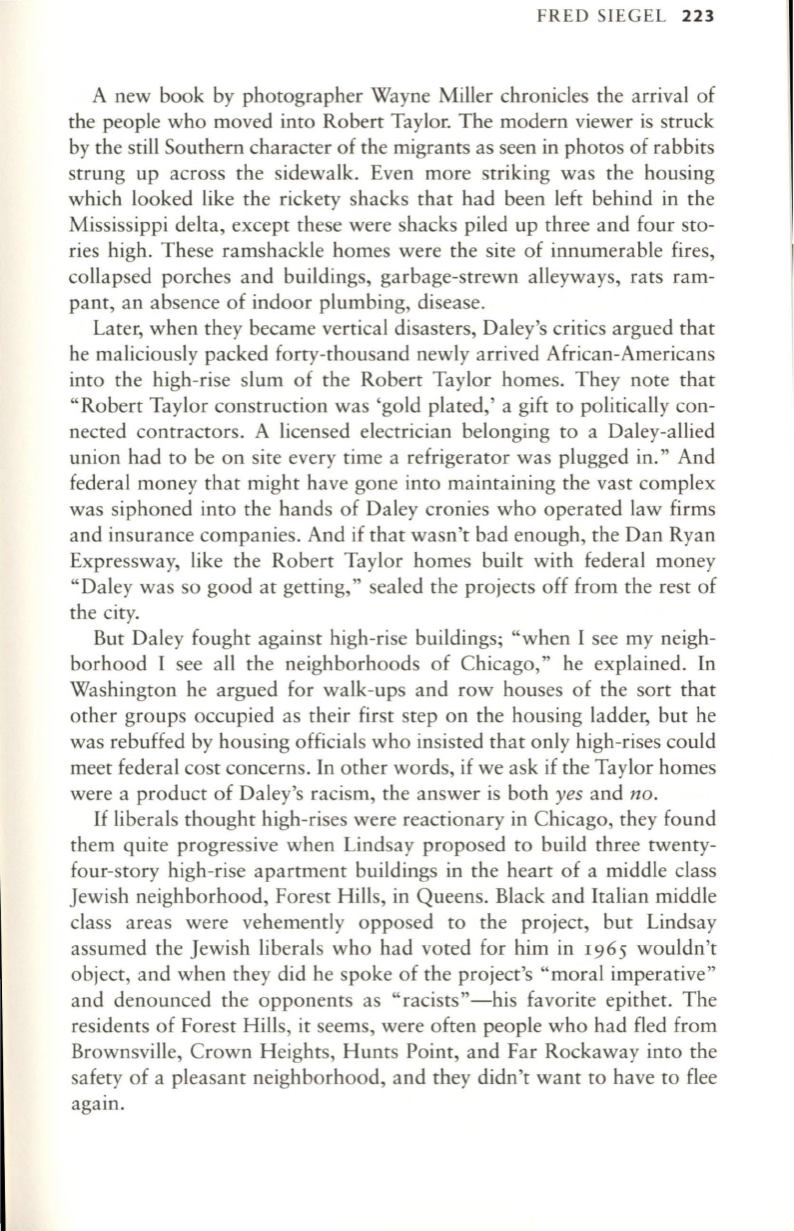
FRED SIEGEL
223
A new book by photographer Wayne Miller chronicles the arrival of
the people who moved into Robert Taylor. The modern viewer is struck
by the still Southern character of the migrants as seen in photos of rabbits
strung up across the sidewalk. Even more striking was the housing
which looked like the rickety shacks that had been left behind in the
Mississippi delta, except these were shacks piled up three and four sto–
ries high. These ramshackle homes were the site of innumerable fires,
collapsed porches and buildings, garbage-strewn alleyways, rats ram–
pant, an absence of indoor plumbing, disease.
Later, when they became vertical disasters, Daley'S critics argued that
he maliciously packed forty-thousand newly arrived African-Americans
into the high-rise slum of the Robert Taylor homes. They note that
"Robert Taylor construction was 'gold plated,' a gift to politically con–
nected contractors. A licensed electrician belonging to a Daley-allied
union had to be on site every time a refrigerator was plugged in." And
federal money that might have gone into maintaining the vast complex
was siphoned into the hands of Daley cronies who operated law firms
and insurance companies. And if that wasn't bad enough, the Dan Ryan
Expressway, like the Robert Taylor homes built with federal money
"Daley was so good at getting," sealed the projects off from the rest of
the city.
But Daley fought against high-rise buildings; "when I see my neigh–
borhood I see all the neighborhoods of Chicago," he explained. In
Washington he argued for walk-ups and row houses of the sort that
other groups occupied as their first step on the housing ladder, but he
was rebuffed by housing officials who insisted that only high-rises could
meet federal cost concerns. In other words, if we ask if the Taylor homes
were a product of Daley'S racism, the answer is both
yes
and
no.
If
liberals thought high-rises were reactionary in Chicago, they found
them quite progressive when Lindsay proposed to build three twenty–
four-story high-rise apartment buildings in the heart of a middle class
Jewish neighborhood, Forest Hills, in Queens. Black and Italian middle
class areas were vehemently opposed to the project, but Lindsay
assumed the Jewish liberals who had voted for him in
1965
wouldn't
object, and when they did he spoke of the project's "moral imperative"
and denounced the opponents as "racists"-his favorite epithet. The
residents of Forest Hills, it seems, were often people who had fled from
Brownsville, Crown Heights, Hunts Point, and Far Rockaway into the
safety of a pleasant neighborhood, and they didn't want to have to flee
agam.


